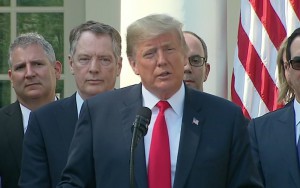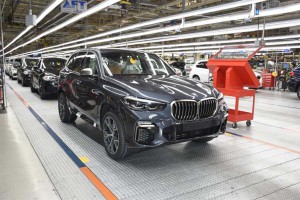
Cecilia Malmstrom, the EU's top trade official, warned that if the Trump administration implemented auto tariffs on the EU, the union would respond in kind.
If President Donald Trump makes good on a threat to impose a 25% tariff on cars and trucks imported into the United States from Europe, the European Union is prepared to implement a new policy of its own: an eye for an eye.
Cecilia Malmstrom, the top trade official for the European Union, met with U.S. Trade Representative Robert Lighthizer to talk about trade issues. After the meeting, she warned the EU would implement tariffs of equal size and strength on U.S. goods if Trump made good on his threatened auto tariffs.
“It would be a rebalancing list covering a lot of different sectors,” Malmstrom said. “That would be ready if we thought those measures would hit us. We hope not.”
Trump threatened to impose a 25% tariff on all cars, trucks, and auto parts coming into the country and after to some back and forth, the two sides – led by European Commission President Jean Claude Juncker – agreed to a preliminary deal grow trade and avoid the tariffs.
(Automakers on edge about possible tariffs. Click Here for the story.)
However, progress has been slow since the tentative agreement took hold and the pace has Trump ready to fire another salvo of tariffs, hoping to spur the EU to action. Unfortunately, the only action that appears to have occurred is Malmstrom saying she has “a list” of areas where the union would apply taxes in-kind.

President Donald Trump reportedly had to be dissuaded from implementing auto tariffs on the EU last week.
That said, she remains optimistic, stating the goal is to resolvedifferences before things escalate further. “We think there is much more to gain from having a positive agenda jointly,” she said.
Auto tariffs would be harmful to the EU given due to the number that are exported to the U.S. annually. The European Automobile Manufacturers Association estimates the EU shipped more than to $40 billion worth of cars to the U.S. in 2017, Business Insider reported. Additionally, 2.9 million cars were produced in the US by European automakers in 2017, according to the group.
In fact, the current tariffs on aluminum and steel have already had a negative impact on some European automakers. BMW said last week that the trade war had cost the company about $337 million, and that it might have to move some production from Spartanburg, S.C., to China to avoid retaliatory tariffs.
(Click Here for more about the auto industry uniting to challenge Trump tariffs.)
While Trump is talking a good game about the tariffs, Malmstrom is quick to point out that it’s not just the EU that would be hurt if he implements the threatened levies.
“These tariffs would be damaging, not only for the European economy but for the U.S. economy,” Malmstrom said.
The Peterson Institute for International Economics estimated a 25% tariff on autos would result in the loss of 195,000 American jobs over a one-to-three-year period. Malmstrom also told reporters that free trade discussions were ongoing between the U.S. and EU, but were hampered by several including the still-present tariffs on steel and aluminum coming into the US.
(To see more about Trump electing to reject EU’s offer to eliminate all tariffs, Click Here.)
Congress must approve “fast track” authority for the Trump administration to formally begin talks with Europe and the 28 European Union member states must also agree to a framework before talks can begin — a process that could take a year to complete.

